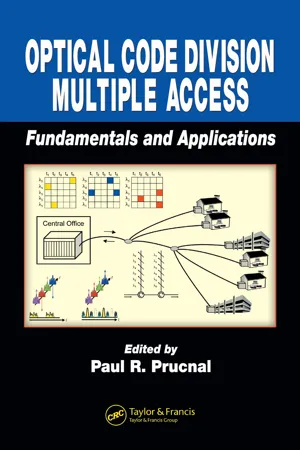Two technical papers form the foundation of most developments in optical code division multiple access (OCDMA) as we know it today. These papers are the one by Prucnal, Santoro, and Fan in 1986, and the one by Weiner, Heritage, and Salehi in 1988. Therefore, many of the chapters in this book are traceable to one or the other of these publications. In this first chapter we’ll put these important publications and their evolution in a historical context. We will also see that there were and are other trends that developed in parallel or as spin-offs of these two seminal papers. These other trends include 2D coding (of which fast frequency hopping [FFH], space/time, and wavelength/time are examples) and hybrids of pulse-position-modulation (PPM) and CDMA, PPM-CDMA. Other trends include direct sequence coherent coding and coherence multiplexing that takes advantage of the limited coherence length of particular light sources to produce a coding regime. We will see that these various trends were based on or driven by applications or emerging device technologies. Certainly, new technologies such as planar lightwave circuits encouraged new applications or implementations of OCDMA. In addition, it was recognized early on that the performance of OCDMA (measured in bit error rate [BER] and number of concurrent users) was limited by multiaccess interference (MAI) so schemes like optical hard-limiting (OHL) and multiuser detection (MUD) were proposed and developed. The performance limitation is particularly severe for coding based on on-off-keying (OOK).
1.1.1 ABCD
For all intents and purposes, the serious development of OCDMA began with the publication of
″Spread spectrum fiber-optic local area network using optical processing‶
Prucnal, P.;Santoro, M.;Ting Fan;
Lightwave Technology, Journal of, Volume: 4 Issue: 5, May 1986
Page(s): 547–554.
(The citation is directly as it appears in IEEEXplore.) The significance of this seminal paper is that it showed a wide audience that pseudo-orthogonal direct sequences such as prime sequence codes could readily be implemented as tapped delay lines based on optical fibers. The correlators or decoders for the encoded data could similarly be implemented as tapped delay lines. This meant that, in a system sense, an optical network could be imagined that allowed sharing of the transmission channel in a multiple access scheme. Furthermore, it meant that the mechanisms that imposed the codes on the data, the encoder, and that recovered a particular set of coded data, the decoder, could be designed to operate without requiring intervention from electronics. Today we would call this “all-optical processing” or “photonic processing” or even “processing at the speed of light.” Generating the data flow in the optical domain did require electrical-to-optical conversion, but encoding/decoding was now an all-optical process. Thus, the portion of the title that says “using optical processing” was indeed an important breakthrough and it triggered new research into the physical implementation of coding schemes.
1.1.2 GFGH
The second, just as important, development was reported in
Optics Letters, Volume 13, Issue 4, 300–302 April 1988
Encoding and decoding of femtosecond pulses
A. M. Weiner, J. P. Heritage, J. A. Salehi
(The citation is directly as it appears in the Optical Society of America Optics INFOBASE.) The key findings were that coherent, narrow-pulse, ultra-wide bandwidth spectra could be produced and manipulated in the spectral or phase domain. In particular, the spectra could be encoded with phase codes. The significance of this is that the developments of radio frequency (RF) communications were now applicable to optical communications. Early on, bipolar and spectral encoding schemes that mimic the codes used in RF communications were added to the knowledge base of OCDMA, as will discussed in the later chapters. (Later coherent OCDMA schemes in which the codes were applied in the time domain, direct sequence codes, were demonstrated, and here, too, RF communications techniques were applicable. These codes were implemented with tranversal filters with similarities to the ones in Prucnal’s work.)
This historical chapter describes and discusses the threads and trends have been part of the evolution of OCDMA. Figure 1.1 shows the trend that includes Prucnal’s seminal work with optical orthogonal codes/pseudo-orthogonal sequences (OOCs/PSOs) [26, 28]. The figure intentionally includes 2D (OOC) codes because we know from personal experience that frustration with the relatively low cardinality and spectral efficiency of OOCs/PSOs, coupled with their problem with MAI, led to an intense interest in the 2D OOCs. This transition of interest occurred around 1990, as shown in Figure 1.1. The figure shows that there is a growing number of researchers in 2D, as well as a growing body of work.
Figure 1.2 shows the threads and trends associated with Weiner’s seminal work [39]. The figure intentionally includes amplitude spectral encoding because the Weiner-Heritage encoding/decoding configuration was adopted as a means to explore the use incoherent broadband sources (e.g., LEDs) instead of the more complex and sensitive coherent sources of the Weiner approach. Again the figure shows an increase of research activity in coherent SE, as well as an increase in the number of investigators.
Figure 1.3 shows the threads and trends associated with FFH concept which we associate with Gelman [38], Tančevski [126], Andonovic [132], Bin [207], and Fathallah [242]. FFHs are somewhat similar to 2D codes (especially since the latter are generally implemented as wavelength/time codes), but 2D codes have somewhat more leeway in allocating resources to the two dimensions and tend to be very permissive of codes with multiple pulses per row and/or column. FFHs tend to have very good cardinality and lend themselves to implementation with modern photonic devices such as Bragg gratings. Thus, there is growing interest in them, and a growing set of investigators.
Figure 1.3 includes the treads and trends of PRF codes. These were the subject of intense research for access and metro applications, with significant participation by Deutsche Telekom and Alcatel SEL. The figure shows that the research has lapsed, although there were excellent results by Alcatel in testbeds and field trials. Similar figures can be configured for coherent OCDMA, coherence multiplexing, PPM-CDMA, OHL, and multiuser detection (MUD).



